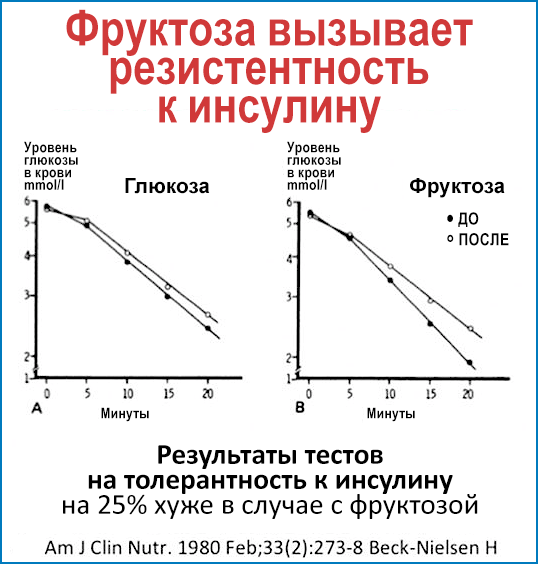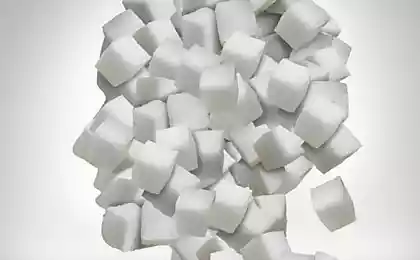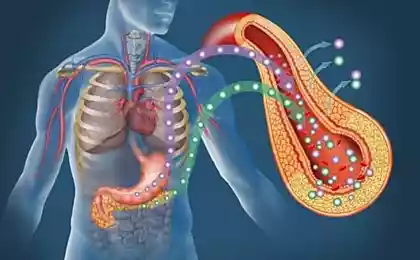573
Fructose: the poison, all — medicine; that, and the other defines dose
Fructose is more closely tied to obesity and diabetes than glucose. From the point of view of nutrition, neither fructose nor glucose is not contain vital nutrients. And as a sweetener they like.
However, fructose does more harm to human health compared to glucose because of its unique metabolism in the body.

The metabolism of glucose and fructose is different in many ways. Almost every cell in our body can use glucose for energy, but no cells can't use fructose. When fructose enters the body, it can metaboliziruetsa only the liver. While glucose molecules can disperse throughout the body to use as energy, fructose molecules are transformed into guided missiles, flying into the liver.
When we eat a lot of glucose, it begins to circulate in almost every cell in the body that helps to distribute this load. Body tissues, except the liver, treated with 80% eaten glucose. Every cell in the body, including cells of the heart, lungs, muscles, brain and kidneys ready to eat with glucose buffet. This leaves the liver for processing only 20% of glucose load. Most of this glucose is converted to glycogen for storage, leaving little glucose as substrate for the production of new fat.
What can be said about fructose. Large amounts eaten, nutrient go straight to the liver because no other cells can't use or recycle it, thereby greatly increasing the load on the liver. Levels of carbohydrates and insulin can be 10 times higher than in other parts of the circulatory system of the body. Thus, the liver is exposed to much higher levels of carbohydrates — fructose and glucose than any other organ in our body.
Compare the hammer blow and the needle: all the pressure is focused on one point.Sucrose provides equal amounts of glucose and fructose. At that time, as many as 75 kg of normal human tissues process glucose, equal amounts of fructose should be boldly treated only 2.2 kg of liver. What this means in practice: fructose probably has 20 times more likely to cause fatty liver (the key problem leading to insulin resistance) compared to one glucose. This explains how a primitive community could carry an extremely high carbohydrate diet without the development of hyperinsulinemia or insulin resistance.
The liver converts fructose into glucose, lactose and glycogen. There are no restrictions in the system of metabolism for fructose. The more you eat, the more you process. When the limited glycogen stores are filled, excess fructose goes directly to fat the liver through de Novo lipogenesis (DNL). Overfeeding with fructose can increase the DNL by 5 times, and the replacement of glucose by the equal caloric amount of fructose increases the amount of fat in the liver by 38% during the entire 8 days. This is what fatty liver is crucial for the development of insulin resistance.
The ability of fructose to induce fatty liver is unique among carbohydrates. Fatty liver directly causes insulin resistance, setting in motion a vicious circle: hyperinsulinemia — insulin resistance. In addition, the harmful effect of fructose does not require high levels of glucose or insulin in the blood to wreak havoc. Through fatty liver disease and insulin resistance, that lead to the obesity effect is not noticeable in the short term — only for a long time.
The metabolism of ethanol (alcohol) is very similar to the metabolism of fructose. After ingestion, the tissue of the body can absorb only about 20% alcohol, leaving 80% for output directly to the liver, where it is metabolized into acetaldehyde, stimulating de Novo lipogenesis. The bottom line is that alcohol just turns into liver fat.
Excessive consumption of ethanol is a well-known cause of fatty liver. Since fatty liver is an important step on the path to insulin resistance, it is not surprising that excessive consumption of ethanol is a risk factor of metabolic syndrome development.
Fructose and insulin resistance
The fact that eating fructose can cause insulin resistance, was known in 1980. Healthy study participants were given the excess fructose corresponding to 1000 calories a day, and the results showed a worsening of their insulin sensitivity by 25% after 7 days of the experiment! Those who were given 1,000 extra calories of glucose per day, showed no such deterioration.

A later 2009 study confirmed how easy it is fructose causes insulin resistance in healthy volunteers. The subjects were given 25% of their daily calories in the form of Kool-Aid (a brand of flavoured drink from Kraft Foods) sweetened with either glucose or fructose. Although these dosages may seem high, many people now consume about the same amount of sugar in your diet. In the group with fructose, in contrast to the group with glucose, increased insulin resistance so rapidly that the participants could be diagnosed as pre-diabetic. Yet another remarkable fact: for the development of this state only need 8 weeks of overeating fructose.
Just 6 days of excess fructose in your diet raises insulin resistance. 8 weeks will need to obtain a pre-diabetic state. What will happen after decades of high consumption of fructose? The result will be epidemic of diabetes — what is happening now with us. Overeating fructose stimulates the liver obesity leads directly to insulin resistance.
Overeating fructose really is something sinister. Yes, Dr. Robert Lustig is right. Sugar is a poison.
Factors of toxicity
There are a number of reasons for the toxicity of fructose.
First, its metabolism occurs exclusively in the liver, so virtually all of its volume after getting into our body is stored in a newly created fat. Unlike glucose, which all cells absolutely can metabolize.
Secondly, fructose is converted without restrictions. The more we consume fructose, the more intensive is the process of liver de Novo of lipogenesis, and the greater the obesity of the liver. There are no natural brakes in the system to slow the production of new fat. Fructose directly stimulates DNL, independently from insulin because of dietary fructose has minimal effect on glucose levels or insulin levels.
The metabolism of fructose is regulated less rigidly. Thus, it can overload the "export mechanism" of the liver, leading to excessive accumulation of fat in it. We will talk about how the liver tries to rid of the newly created body fat in the next Chapter.
Thirdly, in the body not provided other alternatives for the treatment of fructose. Excess glucose is stored safely and easily in the liver as glycogen. If necessary, transformirovalsya glycogen back into glucose for easy access to energy. Fructose has another mechanism for convenient storage. It is metabolized to fat, which could not easily be converted back.
Because fructose is a natural sugar, and is also considered part of the human diet since ancient times, we must always remember the first principle of toxicology. "Everything is poison, all — medicine; that, and the other defines dose". The body has the ability to handle small amounts of fructose. This does not mean that it can handle an unlimited amount of it without negative health consequences.
Insights
Fructose was once considered harmless because of its low glycemic index. In the short term, the obvious health risks is not enough. Fructose manifests its toxicity is mainly due to the long-term effects, leading to fatty liver and insulin resistance. This effect is often measured in decades, leading to a considerable amount of discussion.
Thus, sucrose or high fructose corn syrup, about equal parts of glucose and fructose, play a dual role in the process of the development of obesity and type 2 diabetes. It's not just "empty calories". It is something far more sinister, and people are gradually beginning to understand this.
Glucose – refined carbohydrate, which directly stimulates insulin. However, most of it can be burned for energy, leaving only a small amount of products of metabolism in the liver. However,very high levels of consumption of glucose also lead to fatty liver. Effects from the consumption of glucose is clearly manifested in the change of blood level and response of insulin.
Overeating fructose produces fatty degeneration of the liver, which in turn directly creates insulin resistance. Fructose is five to ten times more able to cause fatty liver in comparison with glucose, creating an ominous vicious circle. Insulin resistance leads to hyperinsulinemia, as the body tries to overcome this resistance. However, all this backfires because hyperinsulinemia is exacerbated by concomitant glucose load, which leads to a deepening state of insulin resistance.
Therefore, sucrose stimulates the production of insulin, in both the short and long term. Thus, the sucrose is at times more harmful than glucose-containing starches, such as amylopectin.
Looking at the glycemic index, the effect of glucose is obvious, and the effect of fructose is completely hidden.
This fact has long misled scholars, presumerably the role of sugar in the obesity epidemic.
The impact of insulin resistance on obesity builds up over many years or even decades before it becomes obvious. Short-term studies completely missed this effect. Recent system analysis who reviewed many studies with a duration of less than a week, came to the conclusion that fructose does not cause any effect, in addition to the contained calories. But the effects of the consumption of fructose, for example, obesity, develop over decades, not weeks. If we relied on the analysis of only short-term studies about the dangers of Smoking, we could make the same mistake: to consider that Smoking does not cause lung cancer.
Reduction in your diet of sugar and sweets is always considered the first step to weight reduction in almost all diets throughout the history of mankind. Sucrose is not just empty calories or refined carbohydrate. It is far more dangerous, as it simultaneously stimulates the insulin production and a resistance to it. Our ancestors have always known this fact, even if they didn't know physiology.
We tried to deny it during our 50-year obsession with calories. Trying to blame the excess calories, we do not recognize the natural danger from overeating fructose. But it was impossible to deny the truth and ignorance to pay dearly. We paid for a dual epidemic: diabetes type 2 diabetes and obesity. But the unique properties of sugar, leading to obesity, was finally recognized again. It was the truth that was suppressed for a long time.
So when Dr. Lustig presented his lecture in 2009 and said that sugar is a poison, the whole world listened to him with rapt attention. Because this Professor of endocrinology told us what we already instinctively knew and believed to be correct. Despite all the trivial objections and assurances that sugar is not the problem, the world already knew, deep down, the real truth. Sugar is a poison. published
Author: Dr. Jason Fung
P. S. And remember, only by changing their consumption — together we change the world! ©
Source: lchf.ru/14608
However, fructose does more harm to human health compared to glucose because of its unique metabolism in the body.

The metabolism of glucose and fructose is different in many ways. Almost every cell in our body can use glucose for energy, but no cells can't use fructose. When fructose enters the body, it can metaboliziruetsa only the liver. While glucose molecules can disperse throughout the body to use as energy, fructose molecules are transformed into guided missiles, flying into the liver.
When we eat a lot of glucose, it begins to circulate in almost every cell in the body that helps to distribute this load. Body tissues, except the liver, treated with 80% eaten glucose. Every cell in the body, including cells of the heart, lungs, muscles, brain and kidneys ready to eat with glucose buffet. This leaves the liver for processing only 20% of glucose load. Most of this glucose is converted to glycogen for storage, leaving little glucose as substrate for the production of new fat.
What can be said about fructose. Large amounts eaten, nutrient go straight to the liver because no other cells can't use or recycle it, thereby greatly increasing the load on the liver. Levels of carbohydrates and insulin can be 10 times higher than in other parts of the circulatory system of the body. Thus, the liver is exposed to much higher levels of carbohydrates — fructose and glucose than any other organ in our body.
Compare the hammer blow and the needle: all the pressure is focused on one point.Sucrose provides equal amounts of glucose and fructose. At that time, as many as 75 kg of normal human tissues process glucose, equal amounts of fructose should be boldly treated only 2.2 kg of liver. What this means in practice: fructose probably has 20 times more likely to cause fatty liver (the key problem leading to insulin resistance) compared to one glucose. This explains how a primitive community could carry an extremely high carbohydrate diet without the development of hyperinsulinemia or insulin resistance.
The liver converts fructose into glucose, lactose and glycogen. There are no restrictions in the system of metabolism for fructose. The more you eat, the more you process. When the limited glycogen stores are filled, excess fructose goes directly to fat the liver through de Novo lipogenesis (DNL). Overfeeding with fructose can increase the DNL by 5 times, and the replacement of glucose by the equal caloric amount of fructose increases the amount of fat in the liver by 38% during the entire 8 days. This is what fatty liver is crucial for the development of insulin resistance.
The ability of fructose to induce fatty liver is unique among carbohydrates. Fatty liver directly causes insulin resistance, setting in motion a vicious circle: hyperinsulinemia — insulin resistance. In addition, the harmful effect of fructose does not require high levels of glucose or insulin in the blood to wreak havoc. Through fatty liver disease and insulin resistance, that lead to the obesity effect is not noticeable in the short term — only for a long time.
The metabolism of ethanol (alcohol) is very similar to the metabolism of fructose. After ingestion, the tissue of the body can absorb only about 20% alcohol, leaving 80% for output directly to the liver, where it is metabolized into acetaldehyde, stimulating de Novo lipogenesis. The bottom line is that alcohol just turns into liver fat.
Excessive consumption of ethanol is a well-known cause of fatty liver. Since fatty liver is an important step on the path to insulin resistance, it is not surprising that excessive consumption of ethanol is a risk factor of metabolic syndrome development.
Fructose and insulin resistance
The fact that eating fructose can cause insulin resistance, was known in 1980. Healthy study participants were given the excess fructose corresponding to 1000 calories a day, and the results showed a worsening of their insulin sensitivity by 25% after 7 days of the experiment! Those who were given 1,000 extra calories of glucose per day, showed no such deterioration.

A later 2009 study confirmed how easy it is fructose causes insulin resistance in healthy volunteers. The subjects were given 25% of their daily calories in the form of Kool-Aid (a brand of flavoured drink from Kraft Foods) sweetened with either glucose or fructose. Although these dosages may seem high, many people now consume about the same amount of sugar in your diet. In the group with fructose, in contrast to the group with glucose, increased insulin resistance so rapidly that the participants could be diagnosed as pre-diabetic. Yet another remarkable fact: for the development of this state only need 8 weeks of overeating fructose.
Just 6 days of excess fructose in your diet raises insulin resistance. 8 weeks will need to obtain a pre-diabetic state. What will happen after decades of high consumption of fructose? The result will be epidemic of diabetes — what is happening now with us. Overeating fructose stimulates the liver obesity leads directly to insulin resistance.
Overeating fructose really is something sinister. Yes, Dr. Robert Lustig is right. Sugar is a poison.
Factors of toxicity
There are a number of reasons for the toxicity of fructose.
First, its metabolism occurs exclusively in the liver, so virtually all of its volume after getting into our body is stored in a newly created fat. Unlike glucose, which all cells absolutely can metabolize.
Secondly, fructose is converted without restrictions. The more we consume fructose, the more intensive is the process of liver de Novo of lipogenesis, and the greater the obesity of the liver. There are no natural brakes in the system to slow the production of new fat. Fructose directly stimulates DNL, independently from insulin because of dietary fructose has minimal effect on glucose levels or insulin levels.
The metabolism of fructose is regulated less rigidly. Thus, it can overload the "export mechanism" of the liver, leading to excessive accumulation of fat in it. We will talk about how the liver tries to rid of the newly created body fat in the next Chapter.
Thirdly, in the body not provided other alternatives for the treatment of fructose. Excess glucose is stored safely and easily in the liver as glycogen. If necessary, transformirovalsya glycogen back into glucose for easy access to energy. Fructose has another mechanism for convenient storage. It is metabolized to fat, which could not easily be converted back.
Because fructose is a natural sugar, and is also considered part of the human diet since ancient times, we must always remember the first principle of toxicology. "Everything is poison, all — medicine; that, and the other defines dose". The body has the ability to handle small amounts of fructose. This does not mean that it can handle an unlimited amount of it without negative health consequences.
Insights
Fructose was once considered harmless because of its low glycemic index. In the short term, the obvious health risks is not enough. Fructose manifests its toxicity is mainly due to the long-term effects, leading to fatty liver and insulin resistance. This effect is often measured in decades, leading to a considerable amount of discussion.
Thus, sucrose or high fructose corn syrup, about equal parts of glucose and fructose, play a dual role in the process of the development of obesity and type 2 diabetes. It's not just "empty calories". It is something far more sinister, and people are gradually beginning to understand this.
Glucose – refined carbohydrate, which directly stimulates insulin. However, most of it can be burned for energy, leaving only a small amount of products of metabolism in the liver. However,very high levels of consumption of glucose also lead to fatty liver. Effects from the consumption of glucose is clearly manifested in the change of blood level and response of insulin.
Overeating fructose produces fatty degeneration of the liver, which in turn directly creates insulin resistance. Fructose is five to ten times more able to cause fatty liver in comparison with glucose, creating an ominous vicious circle. Insulin resistance leads to hyperinsulinemia, as the body tries to overcome this resistance. However, all this backfires because hyperinsulinemia is exacerbated by concomitant glucose load, which leads to a deepening state of insulin resistance.
Therefore, sucrose stimulates the production of insulin, in both the short and long term. Thus, the sucrose is at times more harmful than glucose-containing starches, such as amylopectin.
Looking at the glycemic index, the effect of glucose is obvious, and the effect of fructose is completely hidden.
This fact has long misled scholars, presumerably the role of sugar in the obesity epidemic.
The impact of insulin resistance on obesity builds up over many years or even decades before it becomes obvious. Short-term studies completely missed this effect. Recent system analysis who reviewed many studies with a duration of less than a week, came to the conclusion that fructose does not cause any effect, in addition to the contained calories. But the effects of the consumption of fructose, for example, obesity, develop over decades, not weeks. If we relied on the analysis of only short-term studies about the dangers of Smoking, we could make the same mistake: to consider that Smoking does not cause lung cancer.
Reduction in your diet of sugar and sweets is always considered the first step to weight reduction in almost all diets throughout the history of mankind. Sucrose is not just empty calories or refined carbohydrate. It is far more dangerous, as it simultaneously stimulates the insulin production and a resistance to it. Our ancestors have always known this fact, even if they didn't know physiology.
We tried to deny it during our 50-year obsession with calories. Trying to blame the excess calories, we do not recognize the natural danger from overeating fructose. But it was impossible to deny the truth and ignorance to pay dearly. We paid for a dual epidemic: diabetes type 2 diabetes and obesity. But the unique properties of sugar, leading to obesity, was finally recognized again. It was the truth that was suppressed for a long time.
So when Dr. Lustig presented his lecture in 2009 and said that sugar is a poison, the whole world listened to him with rapt attention. Because this Professor of endocrinology told us what we already instinctively knew and believed to be correct. Despite all the trivial objections and assurances that sugar is not the problem, the world already knew, deep down, the real truth. Sugar is a poison. published
Author: Dr. Jason Fung
P. S. And remember, only by changing their consumption — together we change the world! ©
Source: lchf.ru/14608























